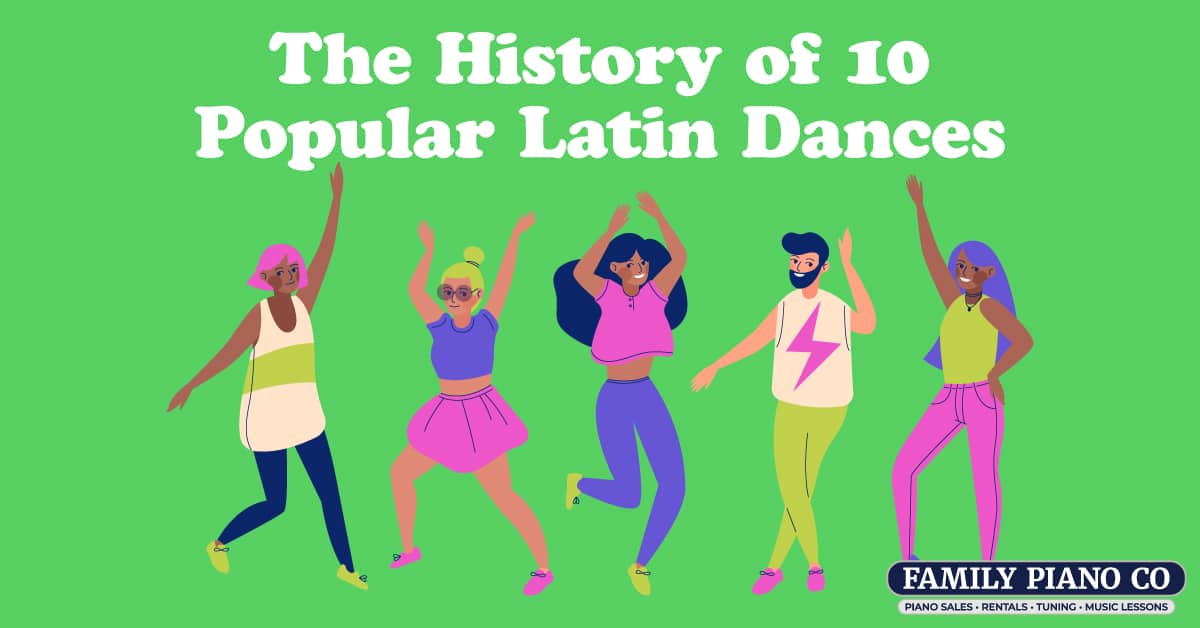
Bachata
Baile Folklórico
Cumbia
“The mother of Latin music,” cumbia is one of the oldest recorded folkloric dances in Latin America. It’s modern form dates back to the late 1800s, when it began developing in Colombia. Like most Latin dances, cumbia has strong African roots stemming from Spanish colonial times. Even the name itself comes from an African language where “cumbe” means dance. The drums are also influenced by African rhythms, but the melody and instrumentation are mostly Indigenous, and the dance has ties to European swing styles. Around the 1940s, cumbia started spreading to other Latin American countries. It has since gained a strong following in Mexico, Argentina, and pretty much every other country in America–including the United States! Over the past couple centuries, the genre and dance have changed significantly from their original Colombian folk styles, and now cumbia is very popular in clubs and parties. The music still has many active artists, and its culture continues to evolve today.
Joropo
Also known as “música llanera” (plain’s music), joropo represents another folk genre, and it’s one that has remained very. . . folk-y. The music goes back to farmers and ranches in Los Llanos, a grassland region within Colombia and Venezuela. The genre is significantly embedded in Spanish influence. The name even comes from a Spanish word meaning, “party.” More importantly, the music features the Spanish harp, a distinct instrument choice for a Latin American genre. The dance also draws several elements from the fandango. Joropo became Venezuela’s national dance in 1882, and it has stayed a popular dance there since. It’s certainly a unique genre in style and sound, and one that is still rooted in its folk origins.
Mambo
Mambo is a style of dance that came out of Cuba as mambo music became popular in the 1940s. It quickly took the place of rhumba as the most popular Latin dance in the United States. Mambo music was developed with danceability in mind. Pioneers of the genre were inspired by danzón, an earlier genre, and they made it more syncopated and less rigid to give dancers more freedom. During the 1960s and 1970s, mambo gained a ton of popularity among Puerto Ricans in New York, and they’ve made it their own since then.
Merengue
Jazz is to the United States was this genre is to Haiti and the Dominican Republic. Its history is deeply rooted in slave culture, drawing heavy influence from African rhythms and the French minuet dance. Similarly, the genre may have gotten its name from meringue cookies, a popular sweet made of sugar and egg whites that slaves would bake. Merengue’s dance is also thought to feature limping motions because slaves who danced it were usually shackled by the feet. Some other interesting merengue history comes from its ties to Dominican dictator Rafael Trujillo. Trujillo began his political campaign in the 1930s, and used the genre and dance to appeal to Dominican citizens. He became strongly associated with the music, and when he was in power, he deemed it DR’s national dance. His brutality then caused Dominicans to flee the country in droves, and they then spread the genre further. Like other Latin dances, merengue has many varieties, each popular in different parts of America. Merengue típico (typical) represent a more traditional form of the genre that dates back to the early 1900s. Of course, you’re bound to see a more modern interpretation of the dance socially.
Punta
The Garifuna are an Afro-indigenous people whose ancestors were survivors of human cargo ships that crashed on St. Vincent. They were soon after exiled to an area that’s now Honduras and Belize. And from there, punta came to life. The word “punta” comes from a Mande language where “bunda” means “butt,” and if you’ve seen the dance, you’d know why that is. It relies heavily on hip movements, isolating the torso and even feet in comparison. Traditionally, punta has been used in ritual settings. Although it may look like a sort of mating dance, the music was a reaction to the Garifuna’s life conditions. And while it was also considered intimate, the genre was always treated by its dancers with respect.
“A Garifuna elder, Rutilia Figueroa, states: “The Garifuna sing their pain. They sing about their concerns. They sing about what’s going on. We dance when there is a death. It’s a tradition [meant] to bring a little joy to the family, but every song has a different meaning. Different words. The Garifuna does not sing about love. The Garifuna sings about things that reach your heart.”
Salsa
One of the more popular Latin rhythms, salsa is a genre and dance with a very extensive history given how relatively new it is. Its earliest traces were recorded in the early 1900s– and since then–it’s been adopted by numerous countries around the world. The exact origins of salsa are highly debated, and I don’t want to anger any side of the Cuba vs Puerto Rico debate. But, it is often agreed that it’s a sum of són, rumba, and danzón, — music that came from Cuban people, African slaves, and European colonizers, respectively. Of course, the genre saw a big breakthrough when Cubans migrated to the United States as a response to the Cuban Revolution in the 1950s. Here, the dance took in additional influences, and those new varieties got new influences, and etc. Notably, Jimmy Pacheco did a lot for the initial growth of the genre and dance in the 1970s. He even gave it the name “salsa.” His New York City label, Fania Records, would go on to sign musical giants such as Celia Cruz, Rubén Blades, Willie Colón, and Héctor Lavoe, among other pioneers.
“When I was rehearsing the band,” Pacheco remembers, “I saw that we had Dominicans, Cubans, Puerto Ricans, and two Jewish fellows. When you make a sauce, you have different ingredients. And when I saw the band and the singer I thought, this is what we got. We got salsa.”
Samba
Brazilian samba probably looks a little different to the ballroom samba you’ve seen on Dancing with the Stars. Samba is the official music of Brazil. The Brazilian composer and researcher Nei Lopes described it as “the most impressive phenomenon of the twentieth century. In 100 years, it went from being a persecuted culture to the symbol of a nation.” Brazil has a number of well-established samba schools. Each year Brazil’s samba schools dance in a parade showcasing different floats and costumes. Here’s a video of the full parade in 2016.
Tango
Tango is a social dance that developed in the Platine region of South America, mainly Uruguay and southern Argentina. Nostalgic and lovelorn lyrics commonly accompany the music, and it’s sound is made distinct with the bandoneon, a small button accordion.
While formalized ballroom tango uses basic forms of the dance, Argentine tango heavily relies on improvisation, and certain sets of codes, and superstitions that are still followed today.




0 Comments